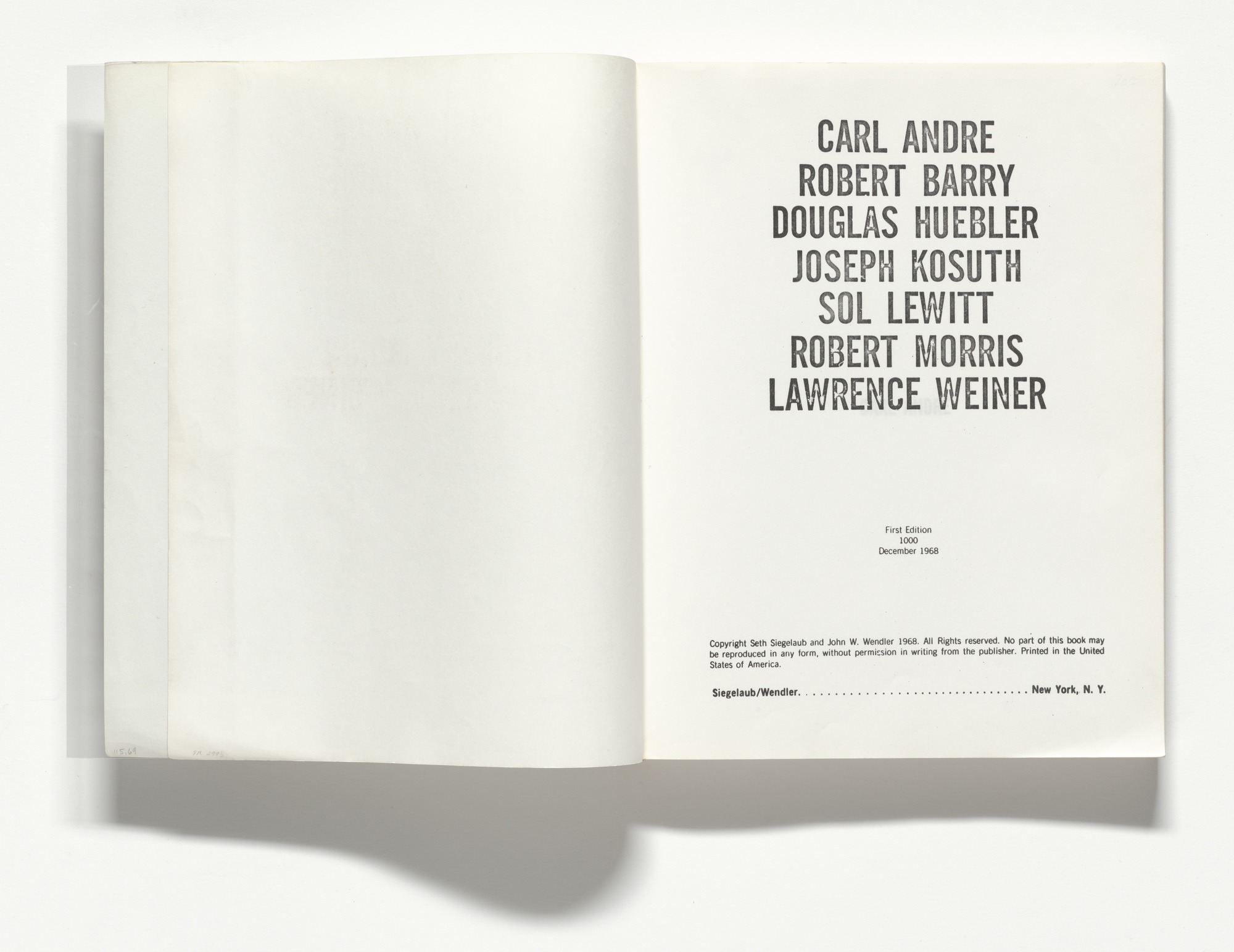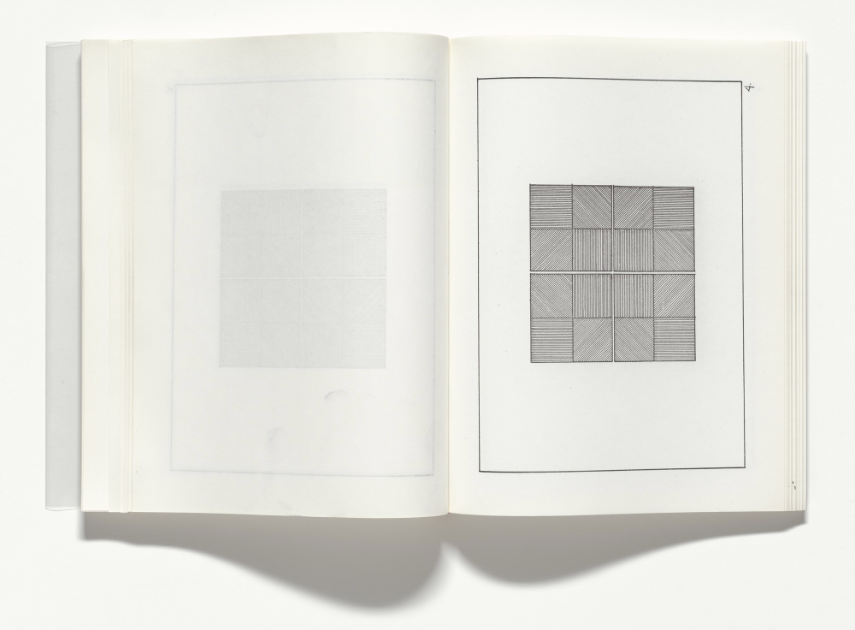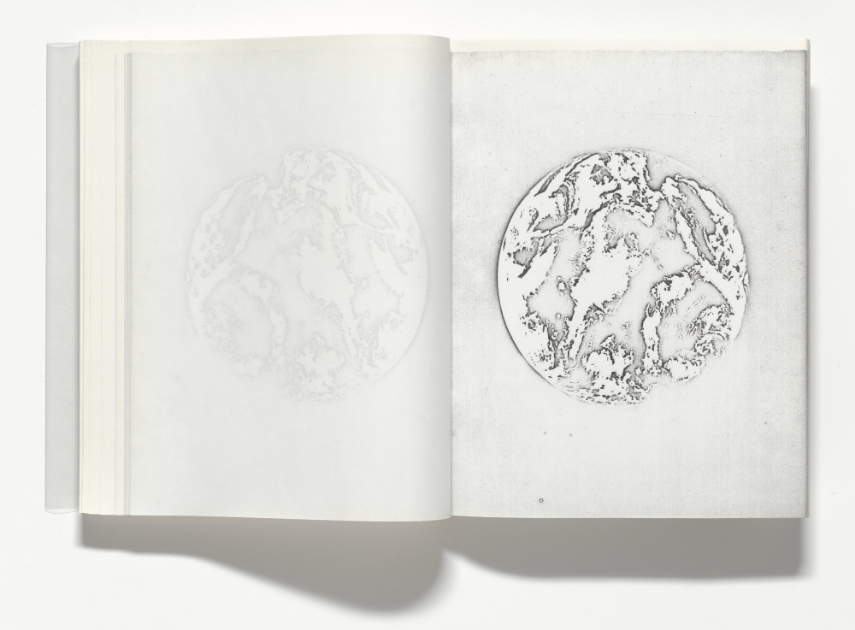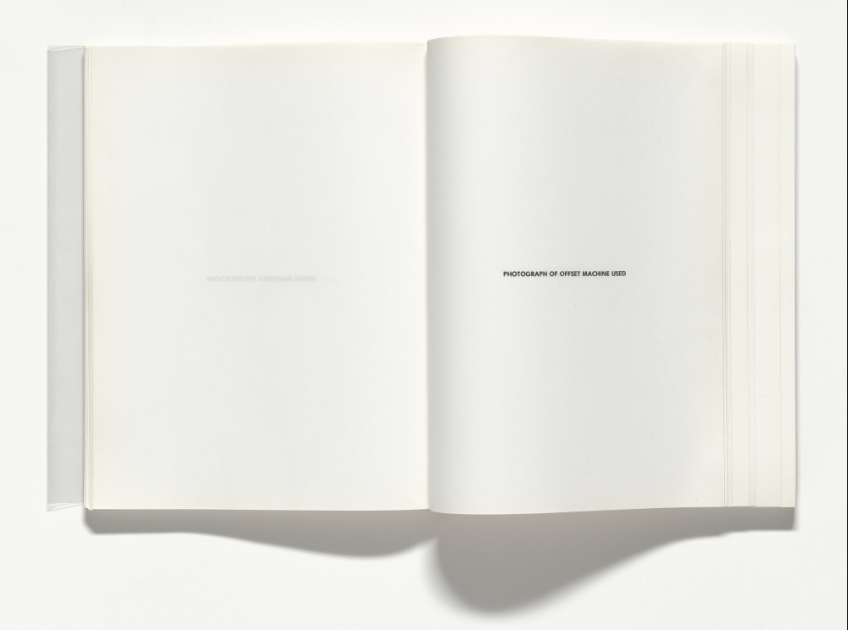Seth Siegelaub, Carl Andre, Robert Barry, Douglas Huebler, Joseph Kosuth, Sol LeWitt, Robert Morris, Lawrence Weiner, AKA the Xerox Book, New York, 1968







A well-known example of a book as exhibition is the catalogue published in 1968 by Seth Siegelaub, which was the sole site for exhibitions of conceptual artists. No other exhibitions took place; thus, this was not a situation in which a book served as a catalogue. Instead, the book publication was the exhibition as it was record and site of the conceptual undertaking. The untitled work, commonly known as the [Xerox Book] (1968) ) included the works of seven artists: Carl Andre, Robert Barry, Douglas Huebler, Joseph Kosuth, Sol LeWitt, Robert Morris, and Lawrence Weiner. Each of them contributed a section to the work, much of which was of a highly self-referential and conceptual variety. It was minimal in its visual and graphic means: there was a Xerox-ed set of lines, some dust, and a simple statement about the page being a photograph of the Xerox machine. Each artist attempted to use the Xerox medium and the imperfection of its reproduction techniques in his individual section. The book is consistent with the direction of these artists’ works at the time, even though the idea of a conceptual exhibition had itself become an art-world convention by this period.1 However, the use of the book as the literal and physical site opened new possibilities.
Seth Seigelaub’s aim to do the show as a catalogue involved one very important aspect of the work called documentation.2 Sol LeWitt, who worked with Siegelaub in some other projects, expressed the importance of what he did:
“Some people’s [artist] work only exists in the documentation. [...] the wall things of mine are a good example because once a show is over, they’re destroyed. The only thing that remains is a photograph of the wall, a drawing of the drawing, and maybe a verbal description of how to draw it. By the thing itself is gone. [...] That’s why I want to be able to use this kind of method that Seth was working on, because that’s the only way these things would be available in his catalogues.”3
In 2014 Lucy Lippard reflected on Siegelaub as the co-inventor of conceptual art by arguing that “distribution was such a huge part of its trajectory, built into the innovative forms many of you came up with. He offered a new context, a way for artists to bypass institutions, the art world’s rites of passages—group show, solo gallery show, reviews, collectors, museum shows, fame…”4 Lippard wanted to achieve something similar with her concept of dematerialization. Documents are important not because they are ubiquitous, but rather because they are so evidently integral to the ways in which people think and live.
Seth Seigelaub’s aim to do the show as a catalogue involved one very important aspect of the work called documentation.2 Sol LeWitt, who worked with Siegelaub in some other projects, expressed the importance of what he did:
“Some people’s [artist] work only exists in the documentation. [...] the wall things of mine are a good example because once a show is over, they’re destroyed. The only thing that remains is a photograph of the wall, a drawing of the drawing, and maybe a verbal description of how to draw it. By the thing itself is gone. [...] That’s why I want to be able to use this kind of method that Seth was working on, because that’s the only way these things would be available in his catalogues.”3
In 2014 Lucy Lippard reflected on Siegelaub as the co-inventor of conceptual art by arguing that “distribution was such a huge part of its trajectory, built into the innovative forms many of you came up with. He offered a new context, a way for artists to bypass institutions, the art world’s rites of passages—group show, solo gallery show, reviews, collectors, museum shows, fame…”4 Lippard wanted to achieve something similar with her concept of dematerialization. Documents are important not because they are ubiquitous, but rather because they are so evidently integral to the ways in which people think and live.
The concept of books as documents focuses on books that serve as documents – either by reproducing a record of an experience or information or by serving as the documents themselves. This is reflected by [Xerox Book], conceptual art documentations. Drucker claims that the idea of the book as a document is hardly an artistic invention. Its ability to serve as a record has extended aspects of conceptual and performance art into book form. As a document, the book becomes a space of information. The standard format of the book serves very well as a place in which an experience, an account, or a testimonial can be produced. A book can be a document that cannot be duplicated elsewhere or it can be a reproduction of an already existing piece. This use of book seems almost obvious, something one might take for granted. In fact, the forms that such books take is quite varied and the formal and structural means by which their presentation is realized ranges from the banal to the extraordinary, as is true of every other realm of artists’ books.
Conceptual art was a way to literally document their immaterial and ephemeral artworks. The [Xerox Book] as a book is a category of material goods and, as Lisa Gitelman points out, an object of commerce and of librarianship and pedagogy, the focus of scholarly domain. Therefore, one may ask, is there a way to revert the commodification or materialization of [Xerox Book]? I believe that the answer lies not in the whole publication, but in the individual artist’s contributions. It is through the narrative of the work, in which artists used 25 sheets to express an idea, and in its sequential, time, and space narratives that we are able not only to separate the commodification but to analyse it through those frameworks.
Another interesting and important narrative to the [Xerox Book] is in name by which it is known. Though it was intended to be published by using a Xerox photocopier, the cost proved to be too high and, in the end, the exhibition was produced using lithographic printing. The name Xerox refers to the Xerox machine. Gitelman states that this machine is important to the document because in addition to reproducing documents, xerography both identifies and creates them. As such, Xeroxing has become a way of seeing documents as documents.5 Xeroxing is reading not in the same way that modern machines such as scanners are said to read, but rather in the way that people are variously trained to read, first by becoming literate and, later, within additional disciplinary frames.6 As such, to Xerox something is to read it as a document.7
1 Johanna Drucker, The Century of Artists’ Books, (New York City: Granary Books, 2004), 322.
2 Leontine Coelewij and Sara Martinetti, eds. Seth Siegelaub: Beyond Conceptual Art (Amsterdam: Stedelijk Museum, 2016), 120.
3 Sol LeWitt and Patricia Norvell, “Sol LeWitt: June 12, 1969,” in Recording Conceptual Art: Early interviews with Barry, Huebler, Kaltenbach, LeWitt, Morris, Oppenheim, Siegelaub, Smithson, and Weiner by Patricia Norvell, ed. Alexander Alberro and Patricia Norvell (Berkeley: University of California Press, 2001), 122.
4 Lucy Lippard. “What to Say about Seth?,” Artforum, February 11, 2014, online at <http://artforum .com/passages/id=45178> (excerpt)
5 Lisa Gitelman, Paper Knowledge: Toward a Media History of Documents (Durham: Duke University Press, 2014), 102.
6 Ibid.
7 Ibid.
Conceptual art was a way to literally document their immaterial and ephemeral artworks. The [Xerox Book] as a book is a category of material goods and, as Lisa Gitelman points out, an object of commerce and of librarianship and pedagogy, the focus of scholarly domain. Therefore, one may ask, is there a way to revert the commodification or materialization of [Xerox Book]? I believe that the answer lies not in the whole publication, but in the individual artist’s contributions. It is through the narrative of the work, in which artists used 25 sheets to express an idea, and in its sequential, time, and space narratives that we are able not only to separate the commodification but to analyse it through those frameworks.
Another interesting and important narrative to the [Xerox Book] is in name by which it is known. Though it was intended to be published by using a Xerox photocopier, the cost proved to be too high and, in the end, the exhibition was produced using lithographic printing. The name Xerox refers to the Xerox machine. Gitelman states that this machine is important to the document because in addition to reproducing documents, xerography both identifies and creates them. As such, Xeroxing has become a way of seeing documents as documents.5 Xeroxing is reading not in the same way that modern machines such as scanners are said to read, but rather in the way that people are variously trained to read, first by becoming literate and, later, within additional disciplinary frames.6 As such, to Xerox something is to read it as a document.7
1 Johanna Drucker, The Century of Artists’ Books, (New York City: Granary Books, 2004), 322.
2 Leontine Coelewij and Sara Martinetti, eds. Seth Siegelaub: Beyond Conceptual Art (Amsterdam: Stedelijk Museum, 2016), 120.
3 Sol LeWitt and Patricia Norvell, “Sol LeWitt: June 12, 1969,” in Recording Conceptual Art: Early interviews with Barry, Huebler, Kaltenbach, LeWitt, Morris, Oppenheim, Siegelaub, Smithson, and Weiner by Patricia Norvell, ed. Alexander Alberro and Patricia Norvell (Berkeley: University of California Press, 2001), 122.
4 Lucy Lippard. “What to Say about Seth?,” Artforum, February 11, 2014, online at <http://artforum .com/passages/id=45178> (excerpt)
5 Lisa Gitelman, Paper Knowledge: Toward a Media History of Documents (Durham: Duke University Press, 2014), 102.
6 Ibid.
7 Ibid.
www.primaryinformation.org
www.moma.org
www.youtube.com